Laurels can be the perfect shrub or tree to have as a hedge between you and your neighbour, or as a stand alone feature tree.
They are evergreen with beautiful shiny lime green leaves, and grow quickly in the right conditions.
Sometimes however, they can struggle – becoming patchy or woody and succumbing to pests and diseases.
Here we will look to answer the question “Why Is My Laurel Hedge Dying?” and also provide solutions to fix the main issues that can affect the Laurel hedge or tree.
2. Leaf Drop Caused by Stress
3. Frost Damage
4. Ivy
5. Fungus: Powdery Mildew or Leaf Spot Fungi
6. Bacteria: Pseudomonas Syringae “Bacterial Shothole”
Leggy Growth
One of Laurel’s mainstay attractions and uses is as a privacy hedge.
With evergreen leaves and bushy growth, it is perfect as a solid but open structured beautiful hedge.
When newly planted however, it can sometimes become tall and leggy.
Although the plant will actually be healthy, if left unattended this can create too much vertical growth and cause large unattractive holes in the hedge.
How to fix:
- If you have purchased the Laurel in a pot, before planting make sure the root ball is not held together in a net. This can constrict root formation and cause lopsided growth.
- Cut away any netting and if the roots are tightly wrapped together around the root ball (root bound) carefully free some of the roots to encourage them to seek water in all directions once planted.
- Once the Laurel has been planted in the ground and is established, it is important to begin to train it into the correct shape.
- This is called “formative pruning“. You can do this in late spring or early summer when the plants are too young to have nesting birds in them. As the plants develop it is best to prune in winter or early spring instead.
- Start by cutting all newly planted Laurel plants back by about a third. This will encourage side growth.
- Then once a year prune again to keep the height and shape you desire.
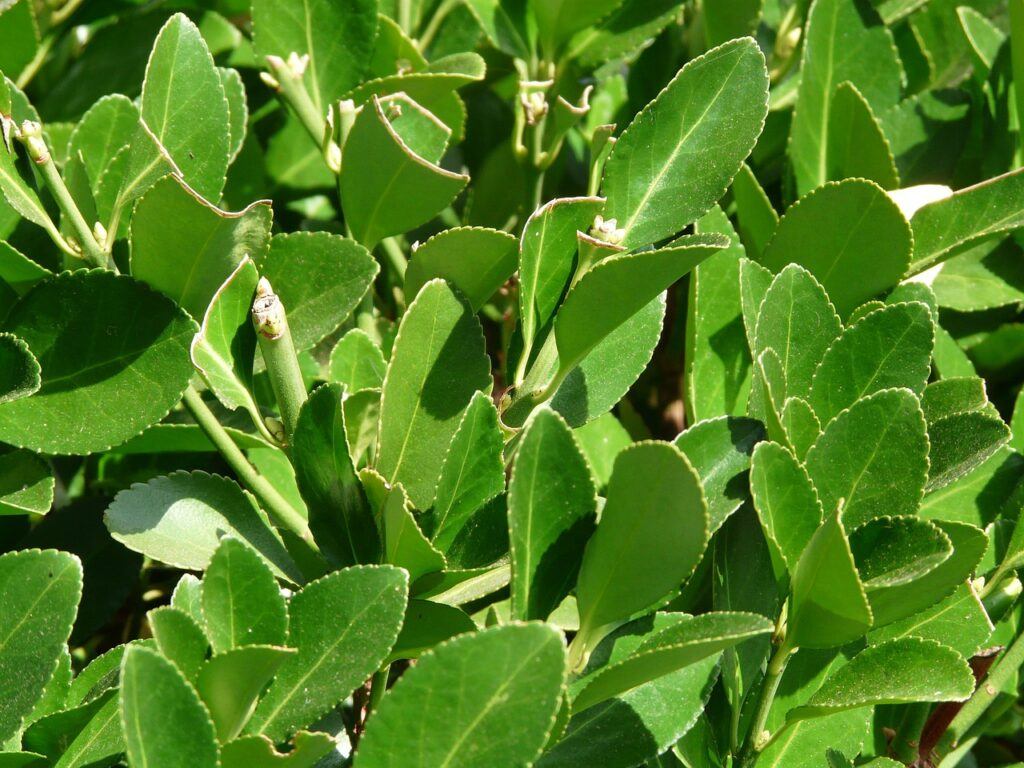
Leaf Drop Caused by Stress
Like many plants, Laurel can become stressed if moved or if subjected to unusual conditions such as heat or lack of water.
If this happens the plant can go into shock and drop it’s leaves as a survival response to conserve water.
How to fix:
- If you are moving or planting a Laurel (or any plant) – try to do it on a cool day and as early in the morning as possible so the plant has maximum water content and time to recover before the warmth of the day.
- Water the plant before moving and prepare the hole so you can minimise the time spent out of the ground.
- Pour some water in your hole so there will definitely be water available for the roots.
- If your soil is particularly free draining then add some compost for nutrients and water retention.
- Once planted, firm in and water well.
- If the weather is very warm then check back every couple of days and water again if needed.
Frost Damage
Being an evergreen plant, Laurels are fairly hardy and can withstand normal winter temperatures.
If there is a sharp frost however, or strong freezing winds this can sometimes cause damage to the leaves.
This can become more pronounced if there is also bright sun.
As the leaves become dehydrated due to the above conditions the plant struggles to get water to them.
The leaves then turn brown or black.
How to fix:
- You can prepare for winter by making sure the Laurel hedge has sufficient water through the autumn. Add some mulch around the base.
- If you can see evidence of frost damaged leaves during winter then water the plant or hedge during the warmest part of the day to allow the plant access to some water.
- The damaged leaves will fall naturally during as spring approaches, or you can snip them off to a healthy node.
- Consider a windbreak or sacking around the most affected parts if you have a particularly cold snap.
Ivy
Ivy can grow up into the middle of a Laurel hedge and wind around the branches adding extra weight and restricting airflow and growth.
Although Ivy is not necessarily harmful and can provide extra habitat for wildlife, if left to grow unchecked it may become larger and heavier than the hedge itself.
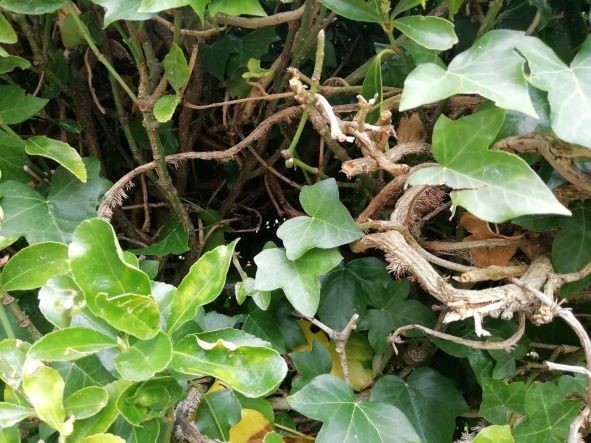
This can then create a dense hedge, instead of the airy open structure that Laurel has without Ivy.
How to fix:
- If the Ivy can be controlled early on then it can become a nice feature, however once the Ivy stems turn wooden it can be much harder to remove or trim.
- Ideally it is best to check on it every few months to make sure it is not overtaking the hedge.
- If it is becoming too large the Ivy will need to be pulled out or pruned to an acceptable size.
- Take care to not disturb nesting birds or other wildlife – ideally avoid late spring and early summer.
- Try to remove the larger woody stems.
Fungus: Powdery Mildew or Leaf Spot Fungi
Laurel hedging can be susceptible to fungus if conditions are humid with limited airflow.
Powdery mildew takes the form of a white dusty substance on the top and bottom of the leaf.
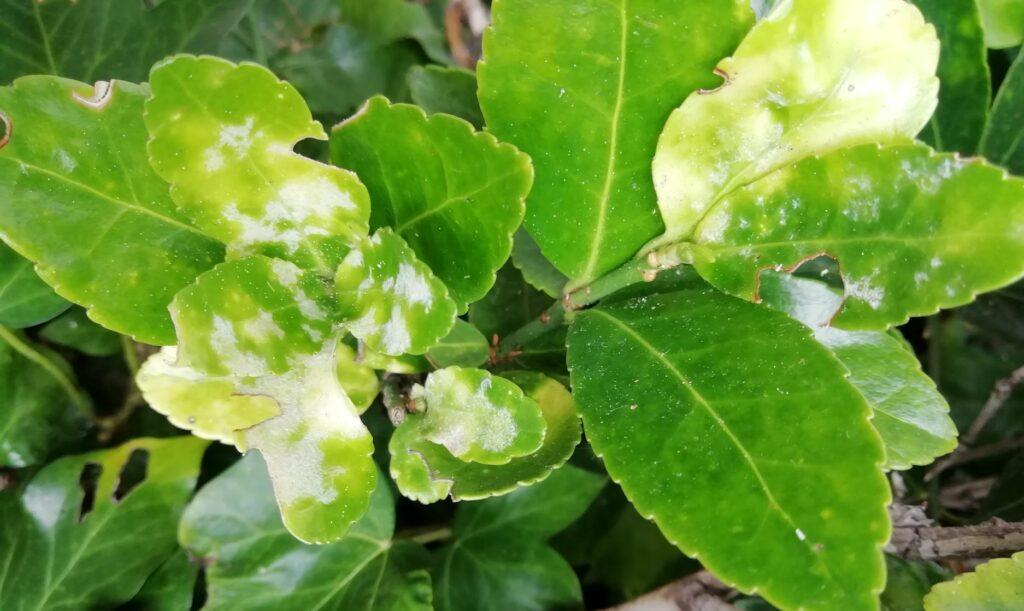
I notice it right at the point where the hedge meets our front door.
The leaf then slowly discolours and turns patchy yellow.
Leaf spot fungi (Eupropolella or Stigminia) presents as brown spots on the leaf that then drop out causing a hole.
Leaves then become ragged and edged with brown dead leaf matter.
How to fix:
- Keep your Laurel hedge or plant pruned to control Ivy and promote good airflow.
- Clear debris, fallen leaves and decaying vegetation from the bottom.
- Sanitise tools such as shears to minimise fungus transference.
- Remove and dispose of affected leaves – not in the compost heap.
- Fungicides are available but the plant should recover once the air conditions become dryer, so I would recommend letting nature address the issue rather than introducing unnecessary chemicals.
Bacteria: Pseudomonas Syringae “Bacterial Shothole”
Pseudomonas syringae “Bacterial shothole” is very similar in appearance to the Leaf spot fungus mentioned above however it is caused by a bacterium rather than a fungus.
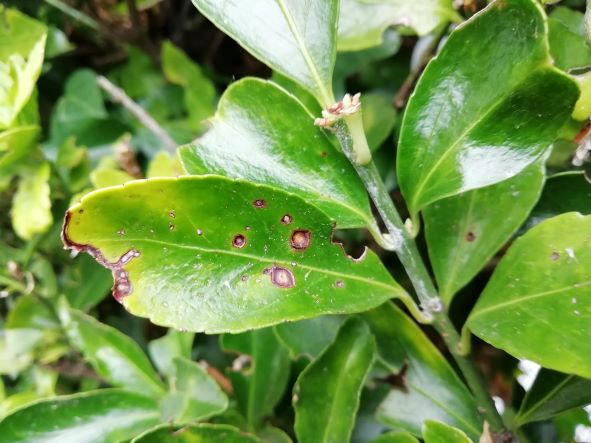
The conditions for spread are similar to that of the fungus – warm moist climate and limited airflow.
Wet leaves seem to be more susceptible.
How to fix:
- Try not to water from above causing the leaves to be splashed – water at the base of the plant.
- Trim the affected leaves off and dispose of them (not in the compost heap).
- Avoid heavy pruning to allow the Laurel time to recover without additional stress.
- Promote your Laurel’s general health by maintaining good hydration, nutrition and airflow – this will create a stronger plant more able to fight off disease by itself.
Conclusion
Laurel is in many ways the perfect evergreen privacy hedge.
It can be used as a boundary between neighbours or even as a visual barrier to hide an area or feature in the garden.
It acts as both a sound and wind break, and attracts nesting birds and other wildlife.
Laurel is perfect for beginner gardeners as it is much easier to maintain than other hedges like Hawthorn and Holly, as it is less woody (and less spiky!).
While generally hardy it can become affected by the issues covered above, when this happens the appearance will degrade and their performance as an attractive privacy hedge will be undermined.
But the good news is, with correct management – Laurel is able to recover well.
This can be achieved by minimising the conditions that cause illness, and promoting the Laurel’s health by protecting and maintaining the growing environment.
If you have any issues with your Laurel hedge that are not covered above, then drop a comment below and I will do my best to help.

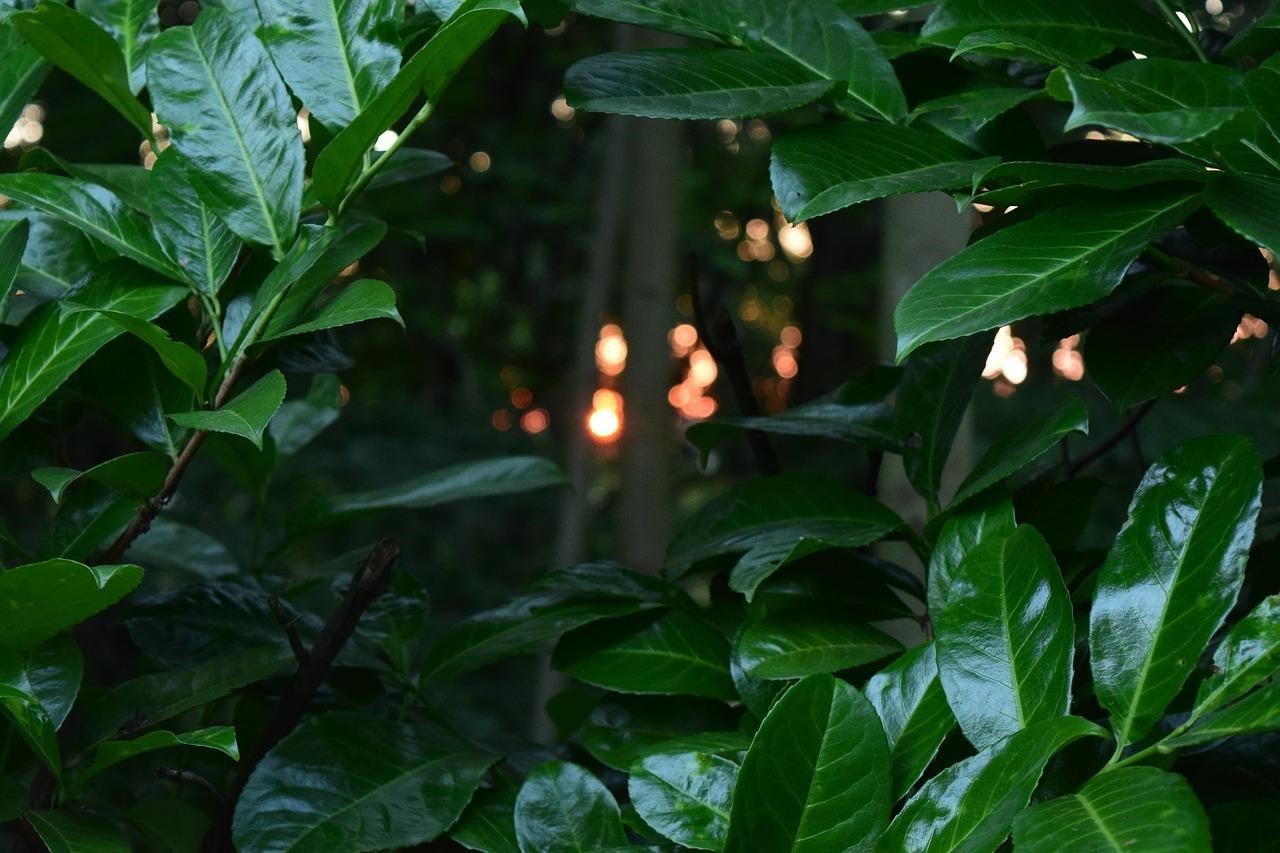
30 year old laurel hedge has died. There is no sign of disease. The garden has been very wet.
Can you help
Thankyou
Dear Susan, I’m sorry to hear that, it can be heartbreaking when large and established plants suddenly die. Let’s get some background – has the whole hedge died? How large is the hedge? What type of soil do you have? The natural lifespan of a Laurel tree is about 50 years so it may be that following a particularly wet season it has perished slightly earlier than normal.
All the best,
Sue
mygardenheaven.com
Hoping you can help. We had four established laurel bushes (at least 10/15 years old) which were pruned in February 21. Conditions were very wet at the time and there was a hard frost with strong winds after the pruning. One of the laurels started to lose its leaves and died completely in the months following. It’s now been removed. The one next to it is now losing most of its leaves and has completely dead sections to it, although there’s some healthy regrowth at the base. The laurel next to that now seems to be ‘catching’ whatever is going wrong, and is experiencing leaf drop on the closest section. There’s no sign of powdery mildew. Could there be a problem with the roots that’s spreading? Do we hard prune back the dead/’infected’ branches and try and create a gap between the remaining bushes? I’m at a loss! Thank you
Dear Helen,
Thanks for your message, it sounds like a root fungal infection. Laurel’s aren’t usually susceptible to these so it is unusual, but given very wet conditions over a prolonged period of time it is possible. The Laurel that died and was removed – did you have a chance to look at the roots? Had they decomposed at all? If so it could be Phytophthora Root Rot. This can sometimes be seen by a dark band appearing around the base of the trunk. Here’s what we usually recommend for this type of infection:
If identified early enough and if a reasonable amount of the roots are still solid and white you can quickly dig up the tree and thoroughly rinse the roots in fresh water.
Any rotten root matter and the surrounding soil should be removed and disposed of (not in the compost heap).
Clean and sterilise any tools used.
Replant the tree in a different location in the garden with better drainage and drier soils.
Monitor to make sure it recovers.
Prevention is better than a cure, so do not overwater susceptible plants in the garden and maintain good ventilation around the stem by regularly clearing debris.
You can prune the dead sections out however I would wait until the weather dries up a bit.
I hope this helps!
Let me know how you get on.
All the best,
Sue X
We had a hard freeze and conditions from 50 to 3 overnight December in Nashville TN. All laurels have dead leaves and I can’t find green when I scrape the large branches. Will cutting back 1/2 the bush help or all they gone? 10 year old bushes
Hi There,
Thank you for your message. That sounds like a substantial temp drop in a short time and it is possible that some of the Laurel has died. I wouldn’t recommend cutting anything back just yet as this will likely shock the plant further. If more cold snaps are forecast you could try to cover the Laurels with fleece or sacking to try and protect them from further damage, this will also help shield them from freezing winds if in an exposed spot. Remember to remove the coverings as soon as the temperatures start to rise however, as they can create more moisture around the plant than is healthy. Once the last chance of frost has passed you can start to see what condition the stems are in, and lightly trim off any dead areas. I’m hoping that as Laurel is reasonably hardy, once the weather warms you should see new growth begin.
I hope this helps!
Let me know how you get on.
All the best,
Sue X
Hi. I hope you can help me. I have two dwarf English laurel, about ten years old. Last year in late summer/early fall I noticed webbing and dying leaves. I sprayed in fall twice with a pesticide for mites. Not specifically neem oil. I followed the directions. Almost all of the bush affected the most has brown leaves. I’m used to seeing some at the end of winter, but it is pretty bad. I’m thinking I’ll do a major pruning in spring. I may even do before flowering, though I usually wait til after flowering.
What advice can you give me and are any of my plans for remediation wrong?
Thanks in advance!
Hi Christa,
Thank you for your message. It sounds like it could have been spider mites, or even genista caterpillars causing the webbing but that sounds like quite a lot of devastation. Your spring prune sounds like a good idea, but wait until there is a nice amount of new healthy growth and then I wouldn’t take off more than a third as this could shock the plant. I would recommend mulching in spring to provide the Laurel with some nutrients as it goes into the growing season. If you applied the pesticide as directed then that sounds fine, but sometimes if applied on a hot day they can scorch the leaves. Sometimes just a decent spray of water can do the job to remove spider mites and caterpillars naturally.
I hope this helps, let me know how you get on.
All the best,
Sue X